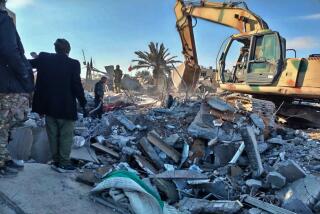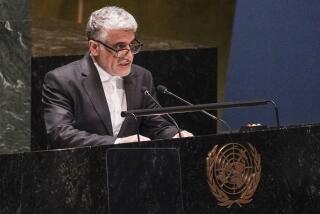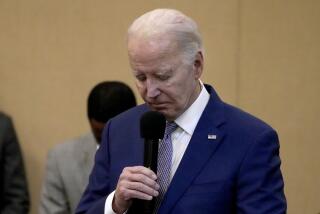Iraq Confrontations Raise Stakes for U.S.
- Share via
WASHINGTON — U.S. pilots have reacted with restraint to provocations in Iraq’s “no-fly” zones, but the Clinton administration will come under intense pressure to respond more forcefully if Americans are downed or captured, experts say.
In the four weeks since the Operation Desert Fox air bombardment, Iraq has confronted U.S. or British planes on eight occasions and sent aircraft into the Western-imposed no-fly zones about 80 times. U.S. planes have answered the challenges by firing missiles at air-defense sites and Iraqi planes, in what officials have portrayed as “proportional” responses.
Experts and congressional aides say the politics of these confrontations will change dramatically if there are multiple U.S. casualties, or if even a single pilot is captured and held hostage.
In either of those events, the experts say, the administration would be pressed to knock out the military assets that have challenged the patrols--by launching broader air campaigns targeted at surface-to-air missile sites, antiaircraft artillery and perhaps the 200-plus planes of the Iraqi air force.
With the seizure of a hostage, “the political calculus will shift, and the pressure will grow on the president to take more dramatic steps,” said Zalmay Khalilzad, a Rand Corp. expert who was a top Pentagon official during the 1991 Persian Gulf War.
Army Gen. Henry H. Shelton, chairman of the Joint Chiefs of Staff, told Congress this month that the military already has plans “on the shelf” for more drastic action.
Some officers commanding U.S. forces in the region believe that more aggressive action is already in order, one defense official said.
President Clinton has come under pressure from Congress to launch preemptive strikes to reduce the threat to U.S. fliers patrolling the region. Sen. John McCain (R-Ariz.) declared at a recent congressional hearing that it is “unconscionable” that U.S. forces had not sought to knock out Iraqi planes before they could shoot down American pilots.
The no-fly zones were set up after the Gulf War to protect Iraqi Kurds in the north and Shiite Muslims in the south. So far, no U.S. or allied pilot has been shot down or captured during the 140,000 overflights undertaken since 1991. U.S. military hardware is generally far superior to Iraq’s planes and SAM batteries.
Even so, a slight risk is not the same as no risk. And with the confrontations now occurring almost daily, the odds of capture or casualties are growing.
Retired Air Force Gen. Thomas G. McInerney said the Iraqis appear to be using “rather sophisticated” radar techniques that give U.S. pilots much less warning that a surface-to-air missile has been fired at them.
He said the Iraqis appear to be aiming their missiles at U.S. planes through optical sighting equipment that gives the pilots only 10 to 15 seconds’ notice, compared with 25 to 40 seconds in the past.
“It’s only a matter of time before they get lucky,” McInerney said.
There is also the risk of a simple engine malfunction.
Kenneth M. Pollack, a Middle East specialist at the National Defense University in Washington, said it is “questionable” how much impact the downing of a single pilot would have on U.S. policy. But a capture “could provoke a very strong U.S. response,” he said.
U.S. officials believe that Iraqi President Saddam Hussein hopes to knock down or capture a pilot through a confrontation in the no-fly zones.
“There’s no doubt in our minds that Saddam would like to shoot down a pilot and have a trophy,” one U.S. official said.
U.S. forces maintain search-and-rescue teams that could swoop in to pick up pilots downed in some parts of the country. But there are concentrations of Iraqi forces that could snatch fliers in parts of the northern no-fly region, as well as in the southern region.
If pilots crash in some isolated desert areas, such as the southwestern desert, they could fall into the hands of Iraq’s population of “stateless” Bedouins, who might--or might not--turn them over to the Iraqis, who are the Bedouins’ nominal government authority.
Experts say there is a good chance that Hussein would want to put any hostage on public display, even though that would invite reprisals by the United States.
“There’s no question he would want to make a big deal out of it,” Khalilzad said.
Since the Desert Fox bombardment, Hussein has shown signs of enormous frustration, according to government and private experts. He wants to demonstrate strength to his domestic audience and to seize the attention of the world in hopes of finally extracting himself from the grip of U.N. economic sanctions, analysts say.
Hussein has a history of parading American captives. During the Gulf War, he upset Americans by publicly displaying U.S. and British fliers downed in Iraq.
More to Read
Sign up for Essential California
The most important California stories and recommendations in your inbox every morning.
You may occasionally receive promotional content from the Los Angeles Times.














